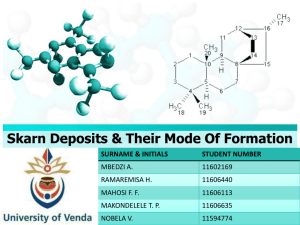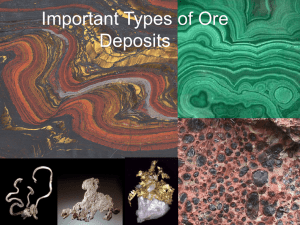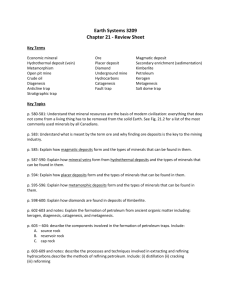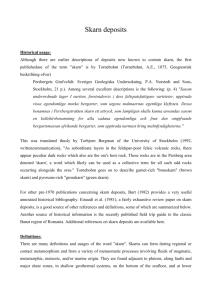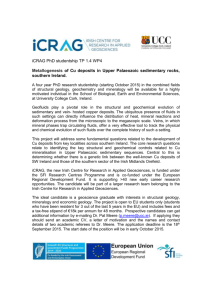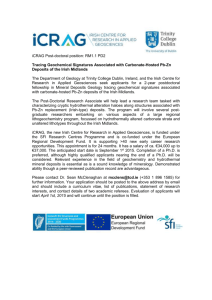Skarn deposits and their mode of formation
advertisement
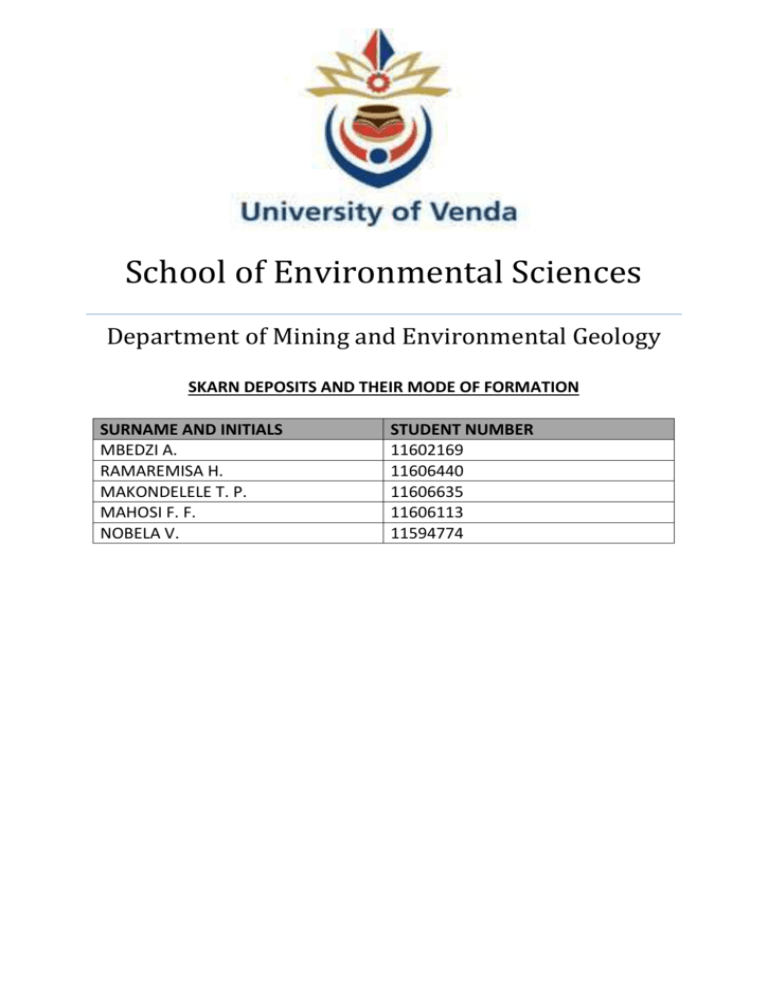
School of Environmental Sciences Department of Mining and Environmental Geology SKARN DEPOSITS AND THEIR MODE OF FORMATION SURNAME AND INITIALS MBEDZI A. RAMAREMISA H. MAKONDELELE T. P. MAHOSI F. F. NOBELA V. STUDENT NUMBER 11602169 11606440 11606635 11606113 11594774 CONTENTS 1. Introduction…………………………………………………………………………………………… 2 2. Evolution of Skarn Deposits……………………………………………………………………. 2 3. Mode of Formation………………………………………………………………………………… 3 3.1. Classification of Skarns…………………………………………………………………….. 3 3.2. Skarn Zonation………………………………………………………………………………….4 4. Skarn Mineralogy……………………………………………………………………………………. 4 5. Types of Skarns………………………………………………………………………………………. 5 5.1. Iron skarn………………………………………………………………………………………… 5 5.2. Gold skarn……………………………………………………………………………………….. 6 5.3. Tungsten skarn………………………………………………………………………………… 6 5.4. Copper skarn……………………………………………………………………………………. 7 5.5. Zinc skarn………………………………………………………………………………………… 8 5.6. Molybdenum skarn………………………………………………………………………….. 9 5.7. Tin skarn………………………………………………………………………………………….. 9 6. Conclusion……………………………………………………………………………………………….10 7. Reference……………………………………………………………………………………………….. 11 SKARN DEPOSITS AND THEIR MODE OF FORMATION/MEG3641 © 2012 1 1. Introduction Skarn refers to calcium-bearing silicates, silicate gangue or waste rock of any age often associated with sulfide deposits of different metals which consequently form as a result of a magma body coming in contact with carbonate sedimentary rocks such as limestone and dolostone. Skarn deposits are mineral occurrences of economically valuable commodities that occur in the skarn environment or as a result of the process of skarnitisation i.e. the process at which the hot waters (fluids) carrying a plethora of metals mix in the contact zone, dissolve calcium-rich carbonate rocks, and convert the host carbonate rock to skarn deposits in a metamorphic known as “metasomatism”. Some of the well-known minerals are mostly associated or form as a result of skarnitisation or found in the skarn environment e.g. apatite, fluorite, corundum, topaz, beryl, and others. Skarns are also referred to as tactites because of the complex mineralogical composition, often as a result of contact metamorphism and metasomatism of carbonate rocks. 2. Evolution of Skarn Deposits The formation of skarn deposits is a dynamic process rather than a simple ideal model and this was also recognised by early skarn researchers e.g. Lindgren, 1902; Barrell, 1907; Goldschmidt, 1911 and others. However, the term skarn was first published by Tornebohm where he stated “As subordinate layers in the feldspar-poor felsic volcanic rocks, there appear peculiar dark rocks which also are the ore’s host rock. These rocks are in the Persberg area denoted ‘skarn’, a word which likely can be used as a collective term for all such odd rocks occurring alongside the ores.” This was translated thusly by Torbjorn Bergman of the University of Stockholm in 1992, then Tornebohm goes on to describe garnet-rich “brunskarn” (brown skarn) and pyroxene-rich “gronskarn” (green skarn). The skarns have gained recognition through their process of formation, and their complex mineralogical association including the ore deposits. Zharikov (1970) was perhaps the first to describe the systematic variations in skarn mineralogy among the major skarn classes. He used phase equilibria, mineral compatibilities, and compositional variations in solid solution series to describe and predict characteristic mineral assemblages for different skarn types. His observations have been extended by Burt (1972) and Einaudi et al. (1981) to include a wide variety of deposit types and the mineralogical variations between types. SKARN DEPOSITS AND THEIR MODE OF FORMATION/MEG3641 © 2012 2 3. Mode of Formation Skarns are in their broadest sense formed by mass and chemical transport and reactions between adjacent lithologies. They need not be igneous in origin; two adjacent sedimentary layers such as banded iron formation and limestone may react to exchange metals and fluids during metamorphism, creating a skarn. Nevertheless, the widest use of the word is in describing the metasomatised zones of wall rock adjacent to granites. Skarns are a class of calc-silicate rocks and are intimately associated with granite intrusions, usually of sedimentary-metamorphic origin (S-type). They are rarely found with other types of granites, because of the fluid chemistry and crystallization behaviour of M-type (mantle origin) and I-type (igneous-metamorphic origin) granites. The S-type granites are more prone to generating late stage fluid rich silica, incompatible elements and halides because they are generally more potassic, oxidised and hydrous. In general, skarns are formed at temperature ranges of roughly 400oC to 650oC and the pressure variables at depths of 1 to 10+ km. Where intrusive contacts are sharply discordant to bedding, skarn cuts across bedding and massively replaces favourable beds, equalling or exceeding the exposed size of the associated pluton (Meinert, 1992). In such an environment, skarn develops in areas where fissures intersect limestone as vein like structures (Nitta et al., 1971; Kawasaki et al., 1985). As stated above, in a deep skarn environment, rocks will tend to deform in a ductile manner, rather than fracture. Intrusive contact with skarn at depth tends to be sub-parallel to joints. In occurrence such as these, skarn is formed along bedding planes or clack of the sedimentary rocks. Interpretation of igneous texture may serve as clue to solve a depth at which not only intrusive rocks are emplaced, but also skarn is formed. If you find intrusive rocks having equigranular texture, it may indicate a deep formation level. Therefore, the formation of skarn at depth in which lithostatic pressure is dominant strongly controlled by structure of host rock, which results in “strata-bounded” deposits. Moreover, some classic skarns are associated with porphyry copper deposits, indicating a relatively shallow depth of emplacement. 3.1. Classification of Skarns Skarns are usually classified according to their origin, dominant mineralogy and other characteristics. Skarns of igneous origin are classified as exoskarns or endoskarns. Exoskarns occur at and outside the granite which produced them, and are alterations of wall rocks. Exoskarns may be classified according to the dominant mineralogy: magnesium (Mg) forsterite, calcic (Ca) andradite, diopside and the majority of the world’s economic skarn deposits occur in calcic exoskarns. Skarn deposits described according to the dominant economic metal or mineral present e.g. copper, iron, tungsten, zinc-lead, molybdenum, tin, talc etc. Endoskarns including greisens, form within the granite mass itself, usually late in the intrusive emplacement and consist of cross-cutting stockworks, cooling joints and around the margins and uppermost sections of the granite itself. Endoskarns are rarer, generally because the fluids created by granite are usually formed in equilibrium with the minerals of the granite. Endoskarns seem to form in granites which lose earlier, more dilute SKARN DEPOSITS AND THEIR MODE OF FORMATION/MEG3641 © 2012 3 hydrous fluids, thereby creating a less dilute last spurt of exsolved fluids. Boiling of the exsolved fluid is also considered important, as this creates a highly saline, incompatibleelement-rich fluid phase and a highly volatile gas phase. Skarns which are created by reaction between metamorphic-sedimentary layers are also known as chemical skarns or skarnoids. Reaction skarns can form from isochemical metamorphism of thinly interlayered shale and carbonate units where metasomatic transfer of components between adjacent lithologies may occur on a small scale (perhaps centimetres). Uncommon types of skarns are formed in contact with sulfidic or carbonaceous rocks such as black shales, graphite shales, banded iron formations and, occasionally, salt or evaporites. Here, fluids react less via chemical exchange of ions, but because of the redox-oxidation potential of the wall rocks. 3.2. Skarn Zonation The spatial and temporal arrangement of minerals in skarn deposits has long been a focus of study. As noted by Burt (1977), European researchers typically have emphasized spatial mineral zoning whereas North American researchers have emphasized spatial mineral zoning in skarn deposits. Both types of zoning occur in skarns and their superposition creates the characteristically complex patterns. In most skarns, there is a general zonation pattern of proximal garnet, distal pyroxene and vesuvianite (or a pyroxene such as wollastonite, bustamite or rhodonite) at the contact between skarn and marble. In addition, individual skarn minerals may display systematic colour or compositional variations within the larger zonation pattern. For example, garnet is commonly dark redbrown in proximal occurrences, becomes lighter brown in more distal occurrences and is pale green near the marble front (e.g. Atkinson and Einaudi, 1978). The change in pyroxene colour is less pronounced but typically reflects a progressive increase in iron and/or manganese toward the marble front (e.g. Harris and Einaudi, 1982). For some skarn systems, these zonation patterns can be “stretched out” for several kilometres and can provide a significant exploration guide (e.g. Meinert, 1987). Exoskarns show zoning of both silicate and ore minerals whereas endoskarn displays zonation resulting from the progressive addition (“back flushing”) of calcium and carbon dioxide into the igneous protolith. A common zonation outwards towards the marble host is biote-amphiboleclinopyroxene-garnet. Potassium feldspar may disappear but plagioclase commonly survives. 4. Skarn Mineralogy The identification and classification of skarn deposits is based on their mineralogy. Although many skarn minerals are typical rock-forming minerals some are less abundant and most have compositional variations that can yield significant information about the environment of formation. Some minerals such as quartz and calcite are present in almost all skarns. Others such as humite, periclase, phlogopite, talc, serpentine and brucite are typical of magnesian skarns but are absent from most other skarn types. Additionally there are many tin, boron, beryllium, and fluorine-bearing minerals which have very restricted but locally important parageneses. SKARN DEPOSITS AND THEIR MODE OF FORMATION/MEG3641 © 2012 4 Modern analytical techniques particularly the electron microprobe make it relatively easy to determine accurate mineral compositions and consequently to use precise mineralogical names. However mineralogical names should be used correctly so as not to imply more than is known about the mineral composition. It is all too common in the geologic literature for specific end-member terms such as diopside to be used when all that is known about the mineral in question is that it might be pyroxene. The main differences between amphiboles in different skarn types are variations in the amounts of Fe, Mg, Mn, Ca, Al, Na and K. Amphiboles in Au, W and Sn skarns are progressively more aluminous (actinolite-hastingsite-hornblende); amphiboles in Cu, Mo and Fe are progressively more iron rich in the tremolite-actinolite series; and amphiboles in zinc skarns are both Mn rich and Ca deficient, ranging from actinolite to dannemorite. For a specific skarn deposit or group of skarns, compositional variations in less common mineral phases such as vesuvianite, bustamite and olivine may provide insight into zonation patterns or regional petrogenesis. Retrograde skarn mineralogy, in the form of epidote, amphibole, chlorite and other hydrous phases is typically structurally controlled and overprints the prograde zonation sequence. Thus, there is often a zone of abundant hydrous minerals along fault, stratigraphic or intrusive contacts. This superposition of later phases can be difficult to discriminate from a spatial zonation sequence due to progressive reaction of metasomatic fluid. It is important to realize that hydrous minerals do not necessarily represent retrograde alteration (e.g. Dick and Hodgson, 1982). For example, the typically high-fluorine activities in tin skarns can stabilize many hydrous minerals at high temperatures during early skarn alteration stages (e.g. Lost River in Alaska; Dobson, 1982). In general, retrograde alteration is more intense and more pervasive in shallower skarn systems. In some shallow porphyry copper-related skarn systems, extensive retrograde alteration almost completely obliterates the prograde garnet and pyroxene (Einaudi, 1982a, 1982b). 5. Types of Skarn Deposits Groupings of skarn deposits can be based on descriptive features such as protolith composition, rock type and dominant economic metal(s) as well as genetic features such as mechanism of fluid movement, temperature of formation and extent of magmatic involvement. Seven major skarn types (Fe, Au, W, Cu, Zn, Mo, and Sn) have received significant modern study and several others (including F, C, Pt, U and REE) are locally important. 5.1. Iron skarn The largest skarn deposits are the iron skarns. Iron skarns are mined for their magnetite content and although minor amounts of Cu, Co, Ni and Au may be present, iron is typically the only commodity recovered (Burt, 1983). Many deposits are very large (>500 million tons, with>300 million tons contained Fe) and consist dominantly of magnetite, with only minor silicate gangue. Some deposits contain significant amounts of copper and are transitional to more typical copper skarns. Calcic iron skarns in oceanic island arcs are SKARN DEPOSITS AND THEIR MODE OF FORMATION/MEG3641 © 2012 5 associated with iron- rich plutons intruded into limestone and volcanic wall rocks. In some deposits, the amount of endoskarn may exceed exoskarn. Skarn minerals consist dominantly of garnet and pyroxene, with lesser epidote, ilvaite and actinolite; all are iron rich (Zharikov, 1970). Alteration of igneous rocks is common, with widespread albite, orthoclase and scapolite veins and replacements, in addition to endoskarn. In contrast, magnesian iron skarns are associated with diverse plutons in a variety of tectonic settings; the unifying feature is that they all form from dolomitic wall rocks. In magnesian skarns, the main minerals such as forsterite, diopside, periclase, talc and serpentine do not contain much iron. Thus, the available iron in solution tends to form magnetite rather than andradite or hedenbergile. Over-printing of calcic skarn upon magnesian skarn is reported from many Russian deposits (Sokolov and Grigorev, 1977). In addition, many other skarn types contain pockets of massive magnetite which may be mined for iron on local scale. Most of these occurences form from dolomitic strata or from zones that have experienced prior magnesian metamorphism. 5.2. Gold skarns Most high-grade gold skarns are associated reduced (ilmenite-bearing, Fe3+/Fe2+ <0.75), diorite-granodiorite plutons and dyke or sill complexes. Such skarns are dominated by ironrich pyroxene (typically >Hd50); proximal zones can contain abundant intermediate grandite garnet. Other common minerals include potassium feldspar, scapolite, vesuvianite, and apatite and high chlorine aluminous amphibole. Distal or early zones contain biotite or potassium feldspar hornfels which extend for hundreds of meters beyond massive skarn. Due to clastic rich, carbonaceous nature of sedimentary rocks in these deposits, most skarn is relatively fine grained. Some gold skarns contain unusual late prehnite or wollastonite retrograde alteration (Burt, 1983). 5.3. Tungsten skarns Tungsten skarns are found on most continents, in association with calc-alkalic plutons in major orogenic belts. As a group tungsten skarns are associated with coarse-grained equigranular batholiths (with pegmatite and aplite dykes) surrounded by large, hightemperature, metamorphic aureoles. These features are collectively indicative of a deep environment. Plutons are typically fresh, with only minor myrmekite and plagioclasepyroxene endoskarn zones near contacts. The high-temperature metamorphic aureoles common in the tungsten skarn environment contain abundant calc-silicate hornfels and skarnoid formed from mixed carbonate-pelite sequence. Such metamorphic calc-silicate minerals reflect the composition and texture of the protolith and can be distinguished from ore-grade metasomatic skarn in the field and in laboratory. Newberry and Einaudi (1981) divided tungsten skarns into reduced and oxidised types, based on host rock composition (carbonaceous versus hematitic), skarn mineralogy (ferrous versus ferric iron), and relative depth (metamorphic temperature and involvement of oxygenated ground water). Early skarn assemblages in reduced tungsten skarns are dominated by hedenbergitic pyroxene and lesser grandite garnet, with associated SKARN DEPOSITS AND THEIR MODE OF FORMATION/MEG3641 © 2012 6 dissenminated, fine grained, molybdenum-rich scheelite (powelite). Later garnets are subcalcic (Newberry, 1983) with significant amounts (up to 80 mole %) of spessartine and almandine. This subcalcic garnet associated with leaching of early disseminated scheelite and its redeposition as coarse-grained, often vein-controlled, low-molybdenum scheelite. It is also associated with the introduction of sulphides, such as pyrrhotite, molybdenite, chalcopyrite, sphalerite and arsenopyrite and hydrous minerals such as biotite, hornblende and epidote. In oxidised tungsten skarns, andraditic garnet is more abundant than pyroxene, scheelite is molybdenum poor and ferric iron phases are more common than ferrous phases. For example, at the Springer deposit in Nevada, garnet is abundant and has andraditic rims, pyroxene is diopsidic (<Hd40), epidote is the dominant hydrous mineral, pyrite is more common than pyrrhotite and subcalcic garnet is rare to absent (Newberry, 1983). In general, oxidized tungsten skarns tend to be smaller than reduced tungsten skarns, although the highest grades in both systems typically are associated with hydrous minerals and retrograde alteration. 5.4. Copper skarns Copper skarns are perhaps the world’s most abundant skarn type. They are particularly common in orogenic zones related to subduction, both oceanic and continental settings. Most copper skarns are associated with l-type, magnetite series, calc-alkalic, porphyritic plutons, many of which have cogenetic volcanic rocks, stork work veining, brittle fracturing and brecciation and intense hydrothermal alteration. These are all features indicative of a relatively shallow environment of formation. Most copper skarns form in close proximity to the contacts of stocks with a relatively oxidized skarn mineralogy dominated by andraditic garnet. Other phases include diopsidic pyroxene, vesuvianite, wollastonite, actinolite and epidote. Hematite and magnetite are common in most deposits and the presence of dolomitic wall rocks is coincident with massive magnetite lodes which may be mined on a local scale for iron. As noted by Einaudi et al. (1981), copper skarns commonly are zoned with massive garnetite near the pluton, increasing pyroxene away from the contact and finally, vesuvianite and/or wollastonite occurring near the marble contact. In addition, garnet may be colour zoned from dark reddish-brown proximal to pluton, to green and yellow varieties in distal occurences. Sulphide mineralogy and metal ratios may also be systematically zoned relative to the causative pluton. In general, pyrite and chalcopyrite are most abundant near the pluton, with chalcopyrite increasing away from the pluton and bornite finally occurring in wollastonite zones near marble contact. In copper skarns containing monticellite, bornitechalcocite is dominant Cu-Fe sulphides rather than pyrite-chalcopyrite. The largest copper skarns are associated with mineralized porphyry copper plutons. These deposits can exceed 1 billion tons of combined porphyry and skarn ore with more than 5 billion tons of copper recoverable from skarn. The mineralized plutons exhibit characteristic potassium silicate and sericitic alteration which can be correlated with prograde garnet-pyroxene and retrograde epidote-actinolite respectively in the skarn. SKARN DEPOSITS AND THEIR MODE OF FORMATION/MEG3641 © 2012 7 Intense retrograde alteration is common in copper skarns and may destroy most of the prograde garnet and pyroxene in some porphyry-related deposits. Endoskarn alteration of mineralized plutons is rare. In contrast, barren stocks associated with copper skarns contain abundant epidote-actinolite-chlorite endoskarn and less intense retrograde alteration of skarn. Some copper deposits have coarse-grained actinolite-chalcopyrite-pyrite-magnetite ores but contain only sperse prograde garnet-pyroxene skarn (Monterrosa and RaulCondestable deposits in Peru; Record mine in Oregon; and Cerro de Mercado in Mexico. These deposits provide a link between some copper and iron skarns and deposits with volcanogenic and orthomagnetic affinities. 5.5. Zinc skarns Most zinc skarns occur in continental settings associated with either subduction or rifting. They are mined for ores of zinc, lead and silver although zinc is usually dominant. They are also high grade (10-20% Zn + Pb, 30-300 g/t Ag). Related igneous rocks span a wide range of compositions, from deep-seated batholiths to shallow dyke-sill complexes to surface volcanic extrusions. The common thread linking most zinc skarn ores is their occurrence distal to associated igneous rocks. Zinc skarns can be subdivided according to several criteria, including distance from magmatic source, temperature of formation, relative proportion of skarn and sulphide minerals and geometric shape of the ore body. None of these criteria is entirely satisfactory: a magnetic source cannot be identified for some deposits, most skarns develop over range of temperatures and most large skarn deposits contain both skarn rich and skarn poor ores in a variety of geometric settings, including mantos and chimneys. Megaw et al. (1988) make the important point that many zinc skarn districts, “grade outward from intrusionassociated mineralization to intrusion-free ores, which suggests that those districts lacking known intrusion relationships may not have been traced to their ends”. Similarly, most zinc skarn districts grade outward from skarn-rich mineralization to skarn-poor ores, veins and massive sulphide bodies which may contain few, if any, skarn minerals. Incompletely explored districts may have only some of these zones exposed. As previously noted, however the presence within the system of skarn minerals such as garnet and pyroxene is important because it indicates a restricted geochemical environment which is entirely distinct from other ore types such as Mississippi Valley-type deposits which also contain Zn-Pb-Ag ores but which absolutely lack skarn minerals. Besides their Zn-Pb-Ag metal content, zinc skarns can be distinguished from other skarn types by their distinctive manganese and iron-rich mineralogy, by their occurrence along structural and lithological contacts and by the absence of significant metamorphic aureoles centred on the skarn. Almost all skarn minerals in these deposits can be enriched in manganese, including garnet, pyroxene, olivine, ilvite, pyroxenoid, amphibole, chlorire and serpentine. In some deposits, the pyroxene and garnet ratio and manganese content of pyroxene increase systematically along the fluid flow path as exemplified by Groundhog in New Mexico (Meinert, 1987). This feature has been used to identify proximal and distal skarns and proximal and distal zones within individual skarn deposits. SKARN DEPOSITS AND THEIR MODE OF FORMATION/MEG3641 © 2012 8 The occurrence of zinc skarns in distal portions of major magmatic or hydrothermal systems may make even small deposits potentially useful as exploration guides in poorly exposed districts. Thus, reports of manganese-rich mineral occurrences may provide clues to districts that have not yet received significant exploration activity. 5.6. Molybdenum skarns Most molybdenum skarns are associated with leucocratic granites and range from highgrade relatively small deposits to low-grade bulk tonnage deposits. Numerous small occurrences are also found in Precambrian, stable cratons associated with pegmatite, apatite and other leucocratic rocks (Vokes, 1963). Most molybdenum skarns contain a variety of metals including W, Cu, Zn, Pb, Bi, Sn and U, and some are truly polymetallic. In that several metals need to be recovered together in order for the deposits to be mined economically. Mo-W-Cu is the most common association and some tungsten skarns and copper skarns contain zones of recoverable molybdenum. Most molybdenum skarns occur in silty carbonate or calcareous clastic rocks: Cannivan Gutch in Montana (Darling, 1990) is a notable exception in that it occurs in dolomite. Hedenbergetic pyroxene is the most common calc-silicate mineral reported from molybdenum skarns with lesser grandite garnet (with minor pyralspite component), wollastonite, amphibole and fluorite. This skarn mineralogy indicates a reducing environment with high fluorine activities. 5.7. Tin skarns Tin skarns are almost exclusively associated with high-silica granites generated by partial melting of continental crust usually caused by rifting events. Tin skarns can be subdivided according to several criteria, including proximal versus distal, calcic versus magnesian, skarnrich versus skarn-poor, oxide-rich versus sulphide-rich and greisen versus skarn. Unfortunately, few of these categories are mutually exclusive. Like the zinc skarns, many large tin skarn systems are zoned from skarn rich to skarn poor (or absent). For example, in the Renison Bell area of Tasmania, there is a single large magmatic or hydrothermal system zoned from a proximal calcic tin skarn with minor cassiterite disseminated in a sulphidepoor garnet-pyroxene gangue to a distal magnesian massive sulphide replacement body containing abundant cassiterite and a complete absence of calc-sillicate minerals. The distal massive sulphide ore body (Renison Bell) is a major ore deposit and the proximal skarn body (Pine Hill) had not been and probably never will be mined. Einaudi et al. (1981) emphasized that there is a common thread linking the several types of tin skarn deposits: the characteristic suite of trace elements (Sn, F, B, Be, Li, W, Mo and Rb) in the ore and in associated igneous rocks. This suite distinguishes tin skarns from all other skarn types. Kwak (1987) makes a further distinction in that many tin skarn deposits develop a greisen alteration stage which is superimposed upon the intrusion, early skarn, and unaltered carbonate. Greisen alteration is characterized by high-fluorine activities and the presence of minerals like fluorite, topaz, tourmaline, muscovite, grunerite and ilmenite and abundant quartz. In many cases, this greisen-stage alteration completely destroys earlier alteration SKARN DEPOSITS AND THEIR MODE OF FORMATION/MEG3641 © 2012 9 stages. Of particular importance, greisen-style alteration is absent from all other skarn types. These are several mineralogical features of tin skarns that should be highlighted. Extensive retrograde or greisen alteration of early tin-bearing skarn minerals can liberate this tin and cause it to precipitate in oxide or sulphide ore. 6. Conclusion Whether one thinks of skarn as a rock type or as an alteration of previously existing rocks, skarns are mappable in the field and the basic map unit is defined by skarn mineralogy. A detailed map showing the distribution of skarn mineral phases will yield important information about the overall size, characteristics and genesis of a skarn system. Of course, the skarn mineralogy needs to be interpreted in terms of lithology, structure and timing. Skarns are distinct from many other types of ore deposits. Almost all large skarn deposits are directly related to igneous rocks. One of the most fundamental controls of skarn mineralogy and metal content is the genesis and crystallisation history of the associated pluton. The late stage hydrothermal evolution of the pluton is mirrored by alteration and mineralization in the surrounding rocks. The reactivity of sedimentary rocks, particularly carbonate rocks, accounts for the abundance of skarns in most localities where magma is emplaced in the upper crust. In the world of economic geology, where fluctuating commodity prices and world demand can change an obscure skarn occurrence into a producing mine (and vice versa) in a short period of time, skarn deposits remain interesting economic and academic challenges. It is likely that skarn deposits will remain an important source of many metals in the next century. The challenge will be to predict which ones will be mined and for what commodities. The purpose of this assignment has been to develop the general theme that skarn deposits are understandable, that they amenable to mapping and simple field observations and the modern geochemical techniques yield a fairly clear picture of their evolution. SKARN DEPOSITS AND THEIR MODE OF FORMATION/MEG3641 © 2012 10 7. Reference Burt, D.M., 1972. Mineralogy and geochemistry of Ca-Fe-Si skarn deposits: unpublished Ph.D thesis, Havard University. 256p. Burt, D.M., 1977. Mineralogy and petrology of skarn deposits: Society Italiana Mineralogie Petrolgia Rendicont, v. 33, p. 859-873. Darling, R.S., 1990. Wide range of molybdenite stability reflected in vein assemblages at the carbonate-hosted Cannivan Gutch Stockwork molybdenum deposit, Southwes Montana: Geological Society of America, Abstract with Programs, v. 67, p. A180. Einaudi, M. T., (1982a) Description of Skarns associated with porphyry copper plutons, southwestern North America, in Titley, S. R., ed., Advances in Geology of the Porphyry Copper Deposits, southwestern North America. University of Arizona press, p. 139-184. Einaudi, M. T., (1982b) General features and origin of skarns associated with porphyry copper plutons, southwestern North America, in Titley, S. R., ed., Advances in Geology of the Porphyry Copper Deposits, southwestern North America. University of Arizona press, p. 185210. Kawasaki, M., Yashiro, K. and Yoshimura, F. (1985) Recent exploration of the Mozumi ore deposits in the Kamioka mine – Especially on the relation between fissures and mineralization –. Mining Geol., 35, 145-159 (in Japanese with English abstr.). Kwak, T.A.P., 1987, W-Sn skarn deposits and related metamorphic skarns and granitoids: Developments in Economic Geology, No. 24, Elsevier, Amsterdam, 451p. Megaw, P.K.M., Ruiz, J. and Titley, S.R., 1988. High temperature, carbonate hosted Ag-Pb-Zn (Cu) deposits of northern Mexico: Economic Geology. v. 83, p. 1856-1885. Meinert, L. D. (1992) Skarn and skarn deposit. Geosci. Canada, 19, 145-162. Newberry, R.T., 1983. The formation of subcalcic garnet in scheelite-bearing skarns: Canadian Mineralogist, v. 21, p. 529-544. Nitta, T., Fukabori, Y. and Mishima, H. (1971) On the successful exploration at the lower part of the Mozumi mining area, the Kamioka mine (No.2). Mining Geol., 21, 20-32 (in Japanese with English abstr. Sokolov, G.A. and Grigorev, V.M. 1997. Deposits of iron, in Smirnov, V.I. ed., Ore deposits of the USSR: Pitman, London. V.1, p. 7-113. Vokes, F., 1963. Molybdenum deposits of Canada: Geological Survey of Canada, Economic Geology Report 20, 333p. Zharikov, V.A, 1970. Skarns: International Geology Review. v. 12, p. 541-559, 619-647, 760858. SKARN DEPOSITS AND THEIR MODE OF FORMATION/MEG3641 © 2012 11
